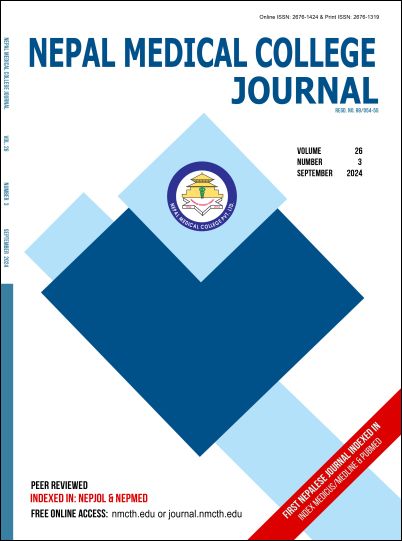Measurement of Anterior Maxillary Alveolar Ridge Dimension and Assessment of Sagittal Root Position by Cone Beam Computerized Tomography (CBCT)
DOI:
https://doi.org/10.3126/nmcj.v26i3.69888Keywords:
Alveolar ridge, anterior maxilla, CBCT, immediate implant, sagittal root positionAbstract
Maxillary anterior region is the implant site that may require the most rigorous pre-operative assessment as it will have a direct influence on aesthetic outcome and stability of the dental implant. In the present study, CBCT (cone beam computerized tomography) images were used to evaluate alveolar ridge dimension in the maxillary anterior region. This observational radiographic study was done at Nepal Medical College Teaching Hospital. The width of the alveolar bone was measured from the labial cortex to the palatal cortex of the maxillary anterior teeth in mm at the alveolar crest (L1), mid-root (L2), and apical root region (L3) for each tooth. Alveolar height was also measured from the alveolar crest to the floor of the nasal fossa. The Sagittal Root Position (SRP) of the maxillary anterior teeth was also assessed. Results showed that the maximum width of the alveolar bone was seen at L3 of canine and lateral incisor showed least width of alveolar bone width at L1. Maximum alveolar bone height was seen in canines. Males were seen to have increased width of the alveolar bone as compared to the females in all anterior teeth. The most frequent sagittal root position was class I which was seen in 270 (51.4%) of the total teeth examined, which was followed by class IV observed in 210 (40%) of the teeth examined. It could be concluded that for maxillary anterior region, additional regeneration therapy maybe required since class I is the most frequent SRP observed.
Downloads
Downloads
Published
How to Cite
Issue
Section
License
Copyright (c) 2024 Nepal Medical College Journal

This work is licensed under a Creative Commons Attribution 4.0 International License.
This license enables reusers to distribute, remix, adapt, and build upon the material in any medium or format, so long as attribution is given to the creator. The license allows for commercial use.




